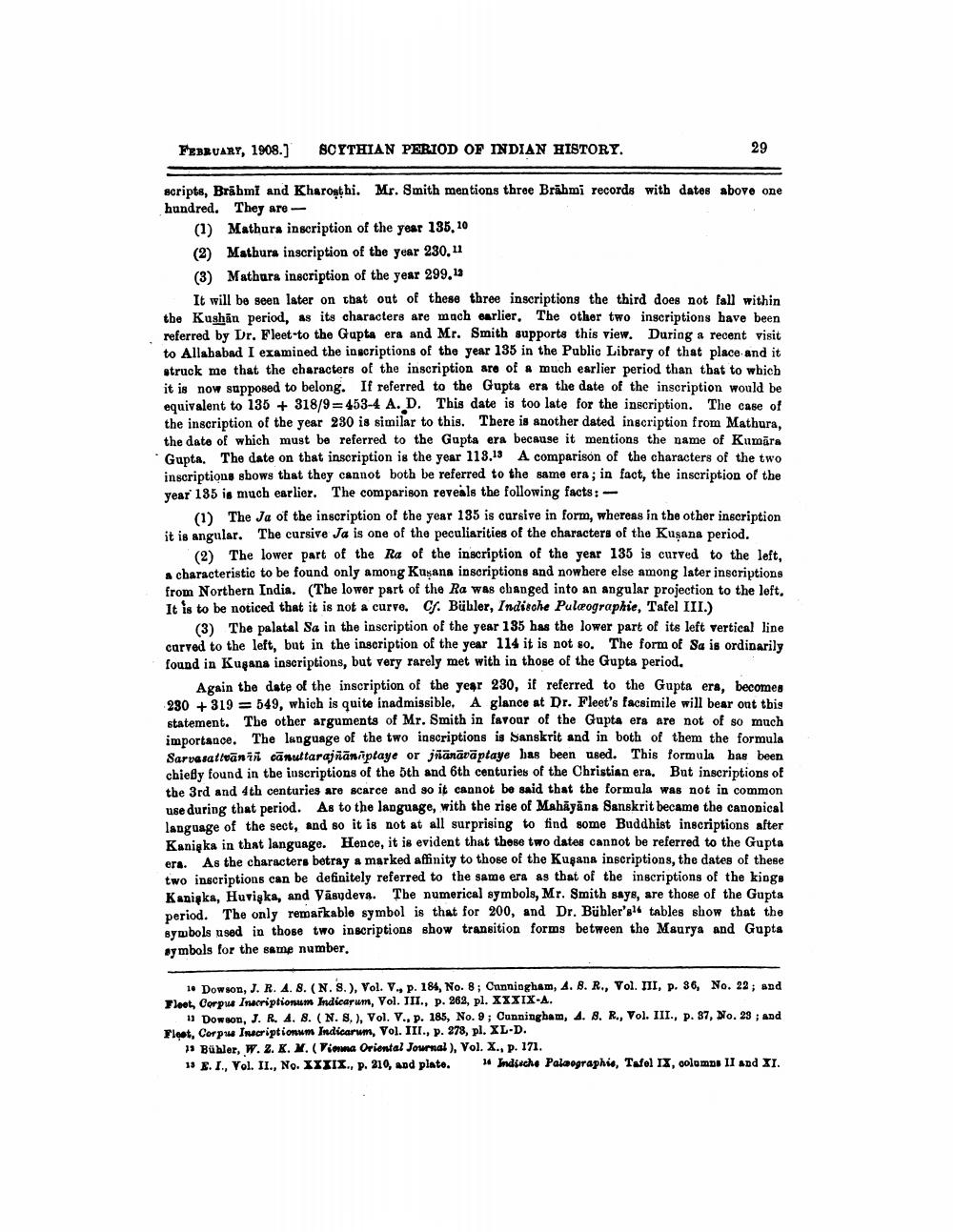________________
SCYTHIAN PERIOD OF INDIAN HISTORY.
29
FEBRUARY, 1908.]
scripts, Brahmi and Kharosthi. Mr. Smith mentions three Brahmi records with dates above one hundred. They are
(1) Mathura inscription of the year 135,10
(2) Mathura inscription of the year 230,11
(3) Mathura inscription of the year 299,13
It will be seen later on that out of these three inscriptions the third does not fall within the Kushan period, as its characters are much earlier. The other two inscriptions have been referred by Dr. Fleet-to the Gupta era and Mr. Smith supports this view. During a recent visit to Allahabad I examined the inscriptions of the year 135 in the Public Library of that place and it struck me that the characters of the inscription are of a much earlier period than that to which it is now supposed to belong. If referred to the Gupta era the date of the inscription would be equivalent to 135 + 318/9-453-4 A. D. This date is too late for the inscription. The case of the inscription of the year 230 is similar to this. There is another dated inscription from Mathura, the date of which must be referred to the Gupta era because it mentions the name of Kumara Gupta. The date on that inscription is the year 113.13 A comparison of the characters of the two inscriptions shows that they cannot both be referred to the same era; in fact, the inscription of the year 135 is much earlier. The comparison reveals the following facts:
(1) The Ja of the inscription of the year 135 is cursive in form, whereas in the other inscription it is angular. The cursive Ja is one of the peculiarities of the characters of the Kusana period.
(2) The lower part of the Ra of the inscription of the year 135 is curved to the left, a characteristic to be found only among Kusana inscriptions and nowhere else among later inscriptions from Northern India. (The lower part of the Ra was changed into an angular projection to the left. It is to be noticed that it is not a curve. Cf. Bühler, Indische Palæographie, Tafel III.)
(3) The palatal Sa in the inscription of the year 135 has the lower part of its left vertical line curved to the left, but in the inscription of the year 114 it is not so. The form of Sa is ordinarily found in Kugana inscriptions, but very rarely met with in those of the Gupta period.
Again the date of the inscription of the year 230, if referred to the Gupta era, becomes 230319 549, which is quite inadmissible. A glance at Dr. Fleet's facsimile will bear ont this statement. The other arguments of Mr. Smith in favour of the Gupta era are not of so much importance. The language of the two inscriptions is Sanskrit and in both of them the formula Sarvasativanin canuttarajñānaptaye or jäänäväptaye has been used. This formula has been chiefly found in the inscriptions of the 5th and 6th centuries of the Christian era. But inscriptions of the 3rd and 4th centuries are scarce and so it cannot be said that the formula was not in common use during that period. As to the language, with the rise of Mahayana Sanskrit became the canonical language of the sect, and so it is not at all surprising to find some Buddhist inscriptions after Kaniaka in that language. Hence, it is evident that these two dates cannot be referred to the Gupta era. As the characters betray a marked affinity to those of the Kugana inscriptions, the dates of these two inscriptions can be definitely referred to the same era as that of the inscriptions of the kings Kanigka, Huviska, and Vasudeva. The numerical symbols, Mr. Smith says, are those of the Gupta period. The only remarkable symbol is that for 200, and Dr. Bühler's tables show that the symbols used in those two inscriptions show transition forms between the Maurya and Gupta symbols for the same number.
10 Dowson, J. R. A. 8. (N. S.), Vol. V., p. 184, No. 8; Cunningham, A. 8. R., Vol. III, p. 36, No. 22; and Fleet, Corpus Inscriptionum Indicarum, Vol. III., p. 262, pl. XXXIX-A.
11 Dowson, J. R. A. 8. (N. S, ), Vol. V., p. 185, No. 9; Cunningham, 4. 8. R., Vol. III., p. 37, No. 29; and Fleet, Corpus Inscriptionum Indicarum, Vol. III., p. 278, pl. XL-D.
13 Bühler, W. Z. K. M. (Vienna Oriental Journal), Vol. X., p. 171.
13 E. I., Vol. II., No. XXXIX., p. 210, and plate. 14 Indische Palæographie, Tafel IX, columns II and XI.




